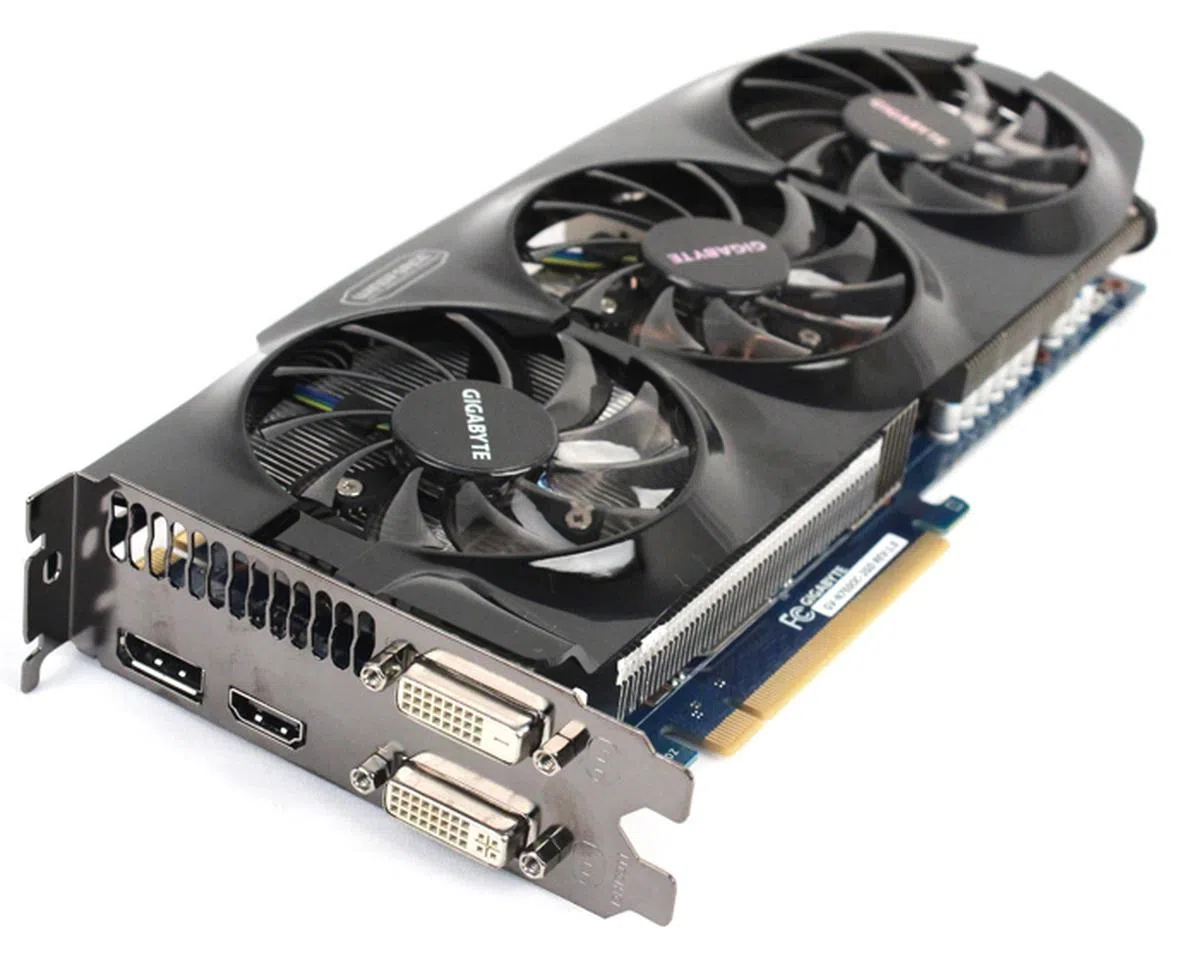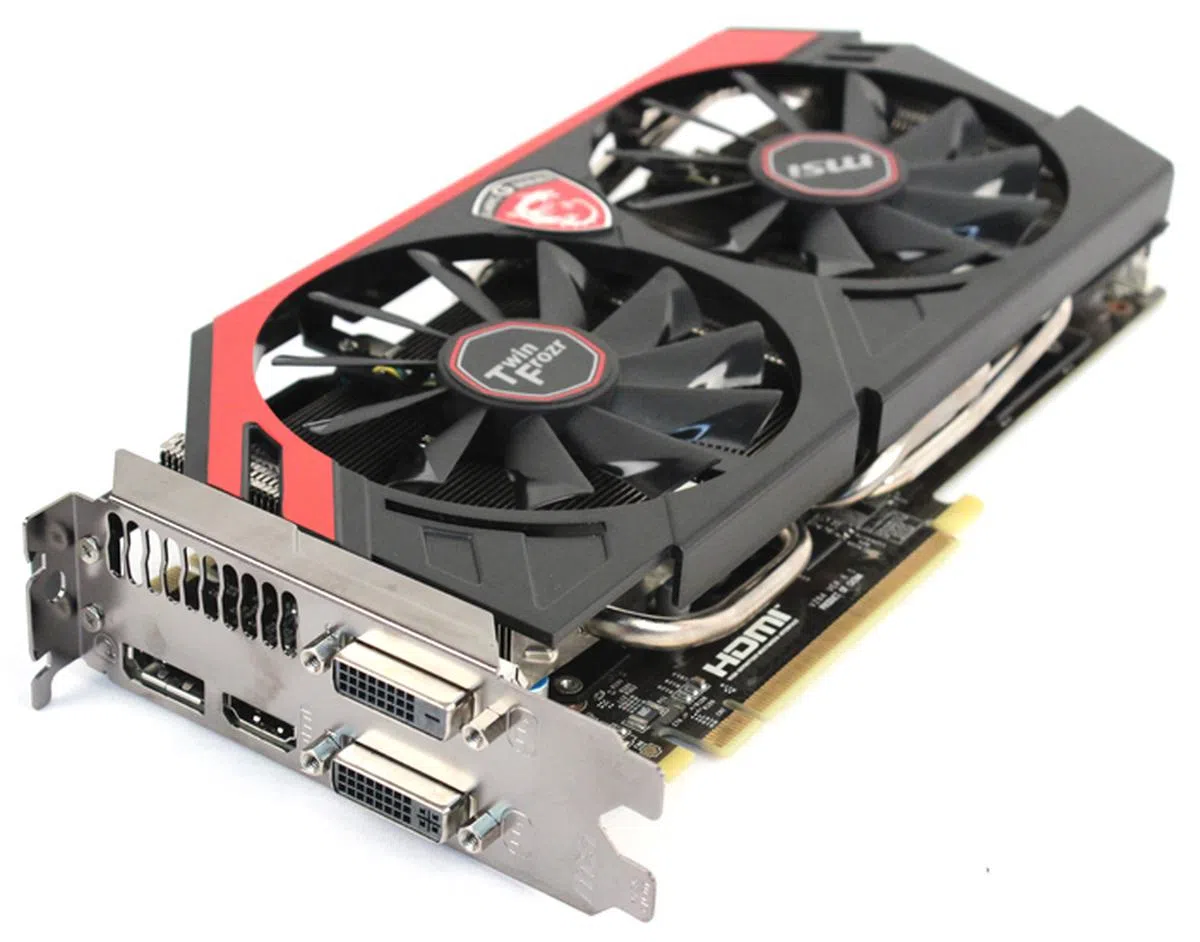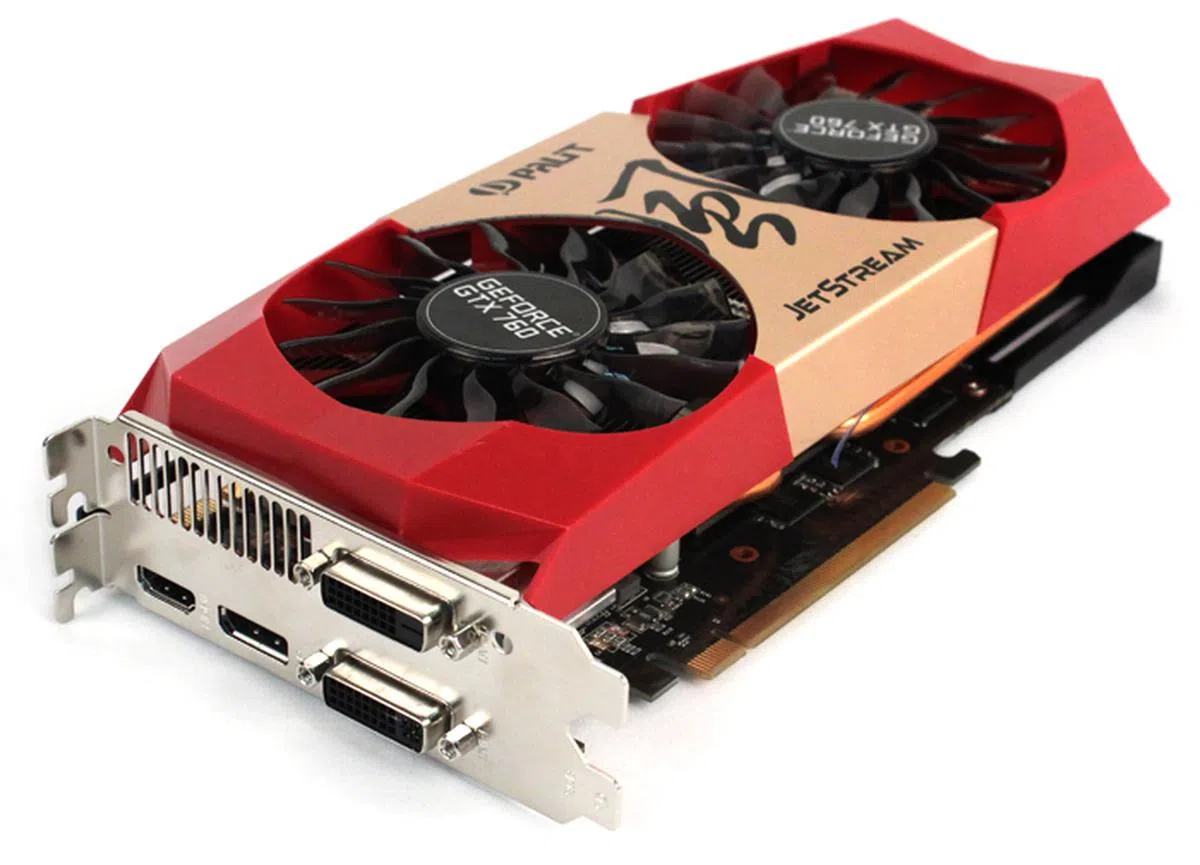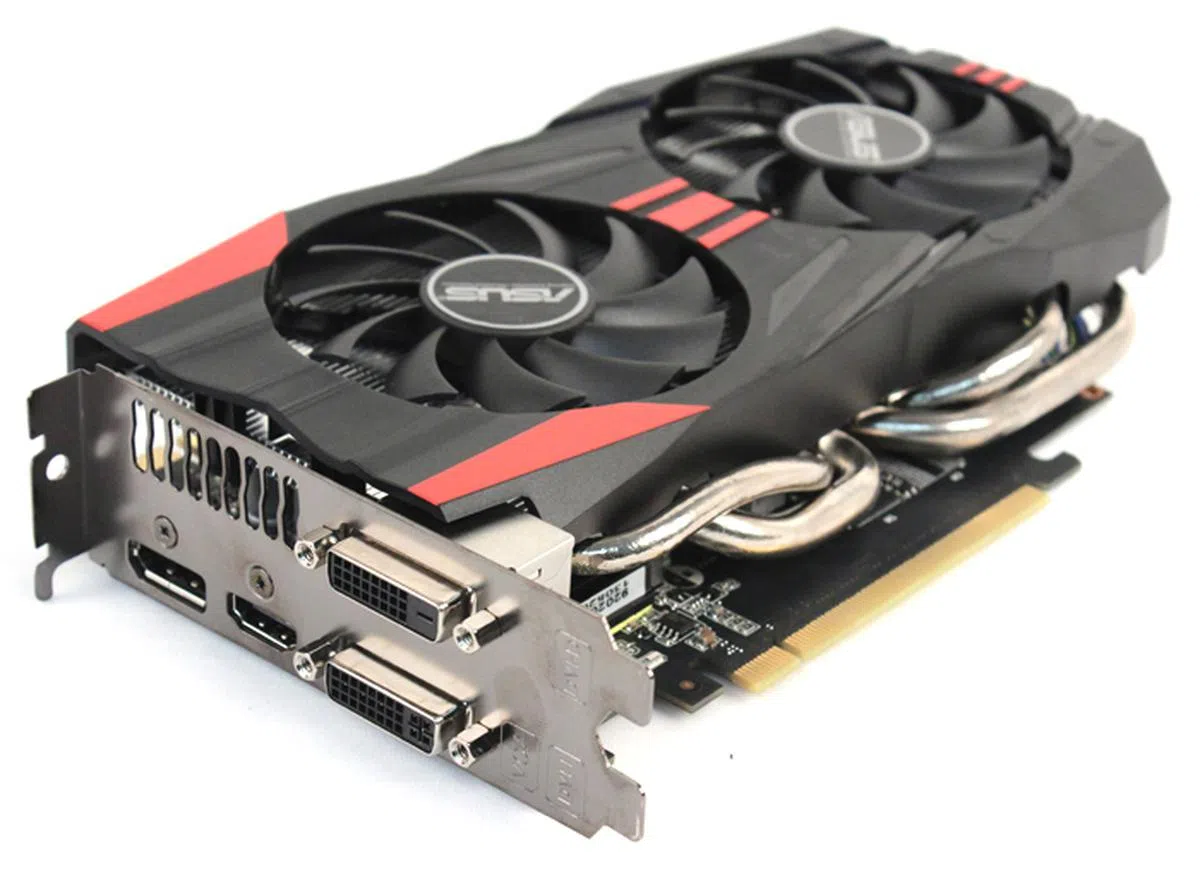NVIDIA GeForce GTX 760 Custom Card Shootout
We weren't too impressed by the reference NVIDIA GeForce GTX 760, but can NVIDIA's add-in partners do any better with their custom cooler models? It's time to find out as we test overclocked versions from ASUS, Gigabyte, MSI and Palit.
Meet the GeForce GTX 760 Custom Cards
We weren't too impressed by the reference NVIDIA GeForce GTX 760, but can NVIDIA's add-in partners can do any better with their custom cooler models? It's time to find out as we test overclocked versions from ASUS, Gigabyte, MSI and Palit.

ASUS GeForce GTX 760 DirectCU II OC
ASUS' GeForce GTX 760 has a light factory overclock of 1006MHz on the core (just 26MHz higher than reference), with memory remaining at the default 6008MHz DDR. As with most of ASUS' custom cards it uses the DirectCU II cooler, with dual 80mm fans and four copper heatpipes in direct contact with the GPU. The card is quite compact (just 8.5 inches long), using a custom shortened PCB that should make it a good choice for mini-ITX and micro-ATX cases. The card retails for S$529 in Singapore and comes with a three-year local warranty.
Update as of 4th July: ASUS has revised its price to a more manageable S$429.


The cooler is very compact, measuring just 218 x 127 x 38mm (about 8.5 inches long).

ASUS is using a custom shortened PCB on this model.

The card requires one 8-pin power connector. Ports are the same as reference: one DVI-D, one DVI-I, one HDMI and one DisplayPort.
Gigabyte GeForce GTX 760 Windforce 3X OC
Gigabyte's GeForce GTX 760 Windforce 3X OC boasts an impressive factory overclock of 1185MHz (105MHz over reference), with memory remaining at the default 6008MHz DDR. It's also the only card in this shootout using a triple fan cooler, Gigabyte's Windforce 3X. Unfortunately, the cooler on this model is made entirely of plastic, rather than the metal Windforce cooler found on Gigabyte's GTX 770 and GTX 780 custom cards. On the plus side, this makes the card remarkably affordable, and it retails for just S$409 with a 3-year local warranty, making it by far the most affordable card in our shootout.


Due to the triple-fan cooler, the card is quite large, measuring 275 x 136.6 x 43mm. That's about 10.8 inches long if you're used to this form of measurement.

Gigabyte is using the reference PCB on this card.

This card requires one 6-pin and one 8-pin power connector. Ports are the same as reference: one DVI-D, one DVI-I, one HDMI and one DisplayPort.
MSI GeForce GTX 760 Twin Frozr IV OC
MSI's GeForce GTX 760 Twin Frozr IV OC has a moderate factory overclock of 1020MHz (40MHz over the reference design) with memory remaining at the default 6008MHz DDR. The card sports MSI's G Gaming Series branding and uses MSI's popular Twin Frozr IV cooler, sporting dual 100mm fans and four copper heatpipes in direct contact with the GPU. MSI also includes an MSI Gaming App software with the card. This app lets you easily boost the core clock speed up to 1080MHz, which would put it just under Gigabyte's factory overclock. Locally, the card retails for S$499 and comes with a three-year warranty.


The card measures 260 x 126 x 38 mm (that's about 10.2 inches long).

MSI is using a custom PCB for this model.

The card requires one 6-pin and one 8-pin power connector. Ports are the same as reference: one DVI-D, one DVI-I, one HDMI and one DisplayPort.

The MSI Gaming app lets you choose between a default gaming overclock (1020MHz) and a higher OC overclock that will boost core clock speeds up to 1080MHz. A Silent mode with lower clock speeds and reduced fan speed is also available.
Palit GeForce GTX 760 JetStream OC
Palit's GeForce GTX 760 JetStream OC also boasts a factory overclock of 1072MHz (92MHz over reference) and is also the only card with overclocked memory, raised to 6200MHz DDR. The card utilizes Palit's JetStream dual-fan cooler and comes in a unique red and gold color scheme. While we imagine Palit was aiming for an Iron Man aesthetic, unfortunately, the red plastic just makes the card look cheap. Perhaps if Palit had opted for a more metallic red finish it would have worked. The card retails in Singapore for S$469 and comes with a two-year warranty.


The red plastic looks a little too cheap for an Iron Man aesthetic. The card measures 245 x 120 x 48mm making slightly wider than 2 PCIe slots, but its length is more manageable at just 9.65 inches.

Palit is using a slightly customized PCB on this model.

Like the reference card, this model requires two 6-pin power connectors. As with all of our cards, it also has the same ports as the reference design: one DVI-D, one DVI-I, one HDMI and one DisplayPort.
[hwzcompare]
[products=400840,400847,400850,400853,400629]
[width=175]
[caption=Custom GeForce GTX 760 Cards Compared]
[showprices=0]
[/hwzcompare]
Test Setup
Here are the hardware specifications of our recently updated graphics card test rig:
- Intel Core i7-3960X (3.3GHz)
- ASUS P9X79 Pro (Intel X79 chipset) Motherboard
- 4 x 2GB DDR3-1600 G.Skill Ripjaws Memory
- Seagate 7200.10 200GB SATA hard drive (OS)
- Western Digital Caviar Black 7200 RPM 1TB SATA hard drive (Benchmarks + Games)
- Windows 7 Ultimate 64-bit
Here's the list of cards we'll be testing and the drivers used:
- ASUS GeForce GTX 760 DirectCU II OC 2GB GDDR5 2GB GDDR5 (NVIDIA ForceWare 320.39)
- Gigabyte GeForce GTX 760 Windforce 3X OC 2GB GDDR5 (NVIDIA ForceWare 320.39)
- MSI GTX 760 Twin Frozr IV OC 2GB GDDR5 (NVIDIA ForceWare 320.39)
- Palit GeForce GTX 760 JetStream OC 2GB GDDR5 (NVIDIA ForceWare 320.39)
- NVIDIA GeForce GTX 760 2GB GDDR5 (NVIDIA ForceWare 320.39)
- NVIDIA GeForce GTX 670 2GB GDDR5 (NVIDIA ForceWare 320.18)
Benchmarks
As usual for our custom card shootouts, we'll be focusing on the overclocking potential, temperature performance, and power consumption of each card (although we'll also have a brief look at out of the box performance). As such, we've streamlined our benchmarks to highlight these features. For a full set of benchmark results for the GTX 760, please refer to our earlier review of the reference NVIDIA GeForce GTX 760.
- Futuremark 3DMark 11
- Crysis 3
- Overclocking (Futuremark 3DMark 11)
- Temperature
- Power Consumption
3DMark 11 Results
3DMark 11 is a synthetic benchmark designed to test a GPU's performance at various aspects of DirectX 11 such as tessellation and DirectCompute. Our custom cards all performed fairly well here, gaining about 6% over the reference card on both presets. Gigabyte was the clear performance winner at the Performance preset, outperforming the rest of the cards by about 3%, however Palit caught up at the Extreme preset. Both ASUS and MSI lagged slightly behind due to their lower default clock speeds.

Crysis 3 Results
For an idea of in-game performance, as usual we tested our cards on Crysis 3, the toughest game in our benchmark set due to its extreme amounts of tessellation, per-pixel per-object motion blur, Bokeh Depth of Field, displacement mapping, particle and volumetric lighting and fog shadows.
Gigabyte was again the leader at all resolutions and settings, however the difference between it and Palit was marginal. ASUS and MSI trailed slightly behind, however there was no real tangible difference in perceivable FPS between any of the four cards in terms of actual gaming experience.


Overclocking Results
For our overclocking efforts we were actually able to achieve the highest overclock with MSI, raising it to a stable overclock of 1133MHz with memory raised to 6600MHz DDR. Despite this, its performance scores on 3DMark wasn't outstanding, and it was actually Gigabyte overclocked to 1130MHz with memory at 6600MHz DDR that scored the highest.
All of our cards gained about 8-10% through overclocking with MSI seeing the biggest gains. Palit was slightly disappointing as we were unable to raise it higher than 1120MHz.


Temperature Results
Unsurprisingly, Gigabyte's Windforce triple-fan cooler proved the most effective at keeping temperatures down, and was closely followed by MSI's 100mm dual-fan Twin Frozr IV design. Both managed to drop temperatures over 10 degrees lower than the reference card. Not that all cards here are operating at their stock clock speeds. As such, Gigabyte's cooler is the most capable since it is the fastest clocked card and yet it registered the lowest operating temperatures at load. Consequently, ASUS seems to be the least impressive given its factory clock speeds even though it's a big leap from the reference card.

Power Consumption Results
Updated on 9th July: The original graph had presented comparison test card results from an older test-bed and thus the differences between the GTX 760 and the rest were more pronounced. We've since rectified the graph, but the conclusion remains that the GTX 760 draws more power than ideal for its caliber.
We noticed some strange behavior when testing power consumption on the reference GTX 760, but fortunately our custom cards seemed to have at least partially corrected that problem. Power consumption was a little lower at load on all models, with Palit displaying the lowest overall draw both while idle and at load. As expected, Gigabyte's high overclock and triple fan cooler drew the most power, however, we were surprised at the high power draw of ASUS' dual-fan DirectCU II cooler.

Conclusion
We weren't entirely convinced by the reference NVIDIA GeForce GTX 760, but we had hopes that the factory overclocked custom card versions would perform better. While there was certainly some performance gain, it still wasn't enough for any of our cards to compete with last year's GTX 670 model and, in fact, performance was only slightly better than the old GTX 660 Ti - at best.
Consider also that with pricing on the GTX 670 dropping as low as S$499 locally, if your budget is around this price-point, you're going to get a lot more bang for your buck by opting for the GTX 670. Only Palit and Gigabyte's GTX 760 cards are priced significantly lower than that, at S$469 and S$409 respectively. If you're looking for something more in the low-to-mid S$400 range, these two might be worth considering. Between the two, we definitely recommend Gigabyte for its better performance, three-year warranty and lower price.
Having said that, unfortunately, we have noticed that current street prices do not seem to match Gigabyte's local distributor's suggested retail price and many vendors are selling the Gigabyte GTX 760 for upwards of $500. While prices should come down eventually, for now, do be careful when you're out shopping and know that there should be room for negotiating a lower price for the card.

Gigabyte is our clear overall winner in this shootout for displaying the best performance out of the box, the best overclocked performance and the best temperature performance. While, like Palit, it uses an entirely plastic cooler, it doesn't look or feel cheap. At an SRP of S$409 ($120 cheaper than ASUS' GTX 760!) it also provides the best value by far.
MSI performed quite well in our overclocking benchmark, but its actual performance scores were slightly lower than expected. Its default factory overclock was also a bit disappointing, and we expect most users will install the MSI gaming app and set it to OC mode (1080MHz) all the time. Under this setting, its performance should be quite close to that of Gigabyte's. Unfortunately, it's still rather expensive at S$499.
Palit performed well out of the box thanks to its high factory core overclock and overclocked memory, however we weren't able to push it much higher in our own overclocking efforts. Its plastic red and gold cooler also looks cheap and didn't perform as well as Gigabyte or MSI - the extra thick 2.5 slot design could also cause problems for SLI spacing or in smaller cases. While it's cheaper than both MSI and ASUS at S$469, it only comes with a two-year warranty.
ASUS didn't perform badly overall, but was hurt by its low factory overclock. The compact size could make a good choice for mini-ITX and micro-ATX builders, but the steep S$529 price tag means that there are better alternatives available. For example, at just S$30 more, you can actually get a more powerful and more compact ASUS GeForce GTX 670 DirectCU Mini OC. Given this situation, we're not quite sure who would opt for the ASUS GeForce GTX 760 DirectCU II OC.
- Update as of 4th July: ASUS has revised its price down to a more manageable S$429. We expect price points to shift across the board for other vendors too as well as they adjust prices with their new stocks. Stay tuned for updates.
Our articles may contain affiliate links. If you buy through these links, we may earn a small commission.






